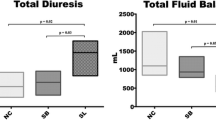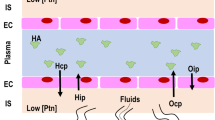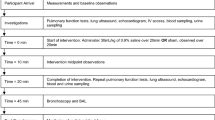Abstract
We investigated the effect of large volume replacement with balanced electrolyte solutions on extravascular lung water (EVLW) in 16 adult surgical patients with sepsis syndrome. Patients entered the study within the 24 h period following surgical interventions for acute necrotizing pancreatitis, intra-abdominal abscesses, and/or peritonitis. Sequential measurements (n=108) were made at intervals of 6–12 h over a 48 h period. There were no significant differences between initial and final values of thermal-dye EVLW (5.0±1.1 vs. 5.7±1.1 ml/kg), plasma colloid osmotic pressure (COP, 13.3±2.5 vs. 13.2±2.9 mmHg), pulmonary artery wedge pressure (PAWP, 9.2±3.0 vs. 10.8±3.0 mmHg), and COP-PAWP gradient (4.0±3.5 vs. 2.4±3.9 mmHg). All results expressed as (mean±SD). The EVLW did not correlate with plasma COP, PAWP, or COP-PAWP gradient. We conclude that large volume replacement with balanced electrolyte solutions with the secondary decrease in plasma COP and COP-PAWP gradient do not necessarily contribute to a substantial increase in EVLW. This study fails to show any causal relationship between decrease in plasma COP or COP-PAWP gradient and oedema formation in the lung.
Similar content being viewed by others
References
Shoemaker WC (1987) Relation of oxygen transport patterns to the pathophysiology and therapy of shock states. Intensive Care Med 13:230
Wolf YG, Cotev S, Perel A, Manny J (1987) Dependence of oxygen consumption on cardiac output in sepsis. Crit Care Med 15:198
Schoemaker WC, Hauser CJ (1979) Critique of crystalloid versus colloid therapy in shock and shock lung. Crit Care Med 7:117
Sturm JA, Wisner DH (1985) Fluid resuscitation of hypovolemia. Intensive Care Med 11:227
Knaus WA, Draper EA, Wagner DP, Zimmerman JE (1985) APACHE II: a severity of disease classification system. Crit Care Med 13:818
Lewis FR, Elings VB, Sturm JA (1979) Bedside measurement of lung water. J Surg Res 27:250
Gaar KA Jr, Taylor AE, Owens LJ, Guyton AC (1967) Pulmonary capillary pressure and filtration coefficient in the isolated perfused lung. Am J Physiol 213:910
Severinghaus JW (1979) Simple, accurate equations for human blood O2 dissociation computations. J Appl Physiol 46:599
Siegel D, Ramanathan S, Chalon J, Turndorf H (1979) An improved program to calculate intrapulmonary shunting. Crit Care Med 7:282
Avila A, Washawski F, Sibbald W, Finley R, Wells G, Holliday R (1985) Peripheral lymph flow in sheep with bacterial peritonitis: evidence for increased peripheral microvascular permeability accompanying systemic sepsis. Surgery 97:685
Brigham KL (1985) Specific organ function/dysfunction in sepsis: pulmonary. In: Sibbald WJ, Sprung CL (eds) Perspectives on Sepsis and Septic Shock. Society of Critical Care Medicine, Fullerton, p 147
Judges D, Sharkey P, Cheung H, Craig I, Driedger AA, Sibbald WJ, Finley R (1986) Pulmonary microvascular fluid flux in a large animal model of sepsis: evidence for increased pulmonary endothelial permeability accompanying surgically induced peritonitis in sheep. Surgery 99:222
Puri VK, Weil MH, Michaels S, Carlson RW (1980) Pulmonary edema associated with reduction in plasma oncotic pressure. Surg Gynecol Obstet 151:344
Rackow EC, Fein IA, Leppo J (1977) Colloid osmotic pressure as a prognostic indicator of pulmonary edema and mortality in the critically ill. Chest 72:709
Rackow EC, Fein IA, Siegel J (1982) The relationship of the colloid osmotic-pulmonary artery wedge pressure gradient to pulmonary edema and mortality in critically ill patients. Chest 82:433
Weil MH, Henning RJ, Morissette M, Michaels S (1978) Relationship between colloid osmotic pressure and pulmonary artery wedge pressure in patients with acute cardiorespiratory failure. Am J Med 64:643
Feeley TW, Mihm FG, Halperin BD, Rosenthal MH (1985) Failure of the colloid oncotic-pulmonary artery wedge pressure gradient to predict changes in extravascular lung water. Crit Care Med 13:1025
Shires GT III, Peitzman AB, Albert SA, Illner H, Silane MF, Perry MO, Shires GT (1983) Response of extravascular lung water to intraoperative fluids. Ann Surg 197:515
Tranbaugh RF, Lewis FR, Christensen JM, Elings VB (1980) Lung water changes after thermal injury. The effect of crystalloid resuscitation and sepsis. Ann Surg 192:479
Taylor AE (1981) Capillary fluid filtration. Starling forces and lymph flow. Circ Res 49:557
Demling RH (1986) Shock and fluids. In: Chernow B, Shoemaker WC (eds) Critical care. State of the Art. Society of Critical Care Medicine, Fullerton, p 301
Gabel JC, Drake RE (1979) Pulmonary capillary pressure and permeability. Crit Care Med 7:92
Allen SJ, Drake RE, Williams JP, Laine GA, Gabel JC (1987) Recent advances in pulmonary edema. Crit Care Med 15:963
Collee GG, Lynch KE, Hill RD, Zapol WM (1987) Bedside measurement of pulmonary capillary pressure in patients with acute respiratory failure. Anesthesiology 66:614
Tranbaugh RF, Lewis FR (1984) Mechanisms and etiologic factors of pulmonary edema. Surg Gynecol Obstet 158:193
Hauser CJ, Shoemaker WC, Turpin I, Goldberg SJ (1980) Oxygen transport responses to colloids and crystalloids in critically ill surgical patients. Surg Gynecol Obstet 150:811
Rackow EC, Falk JL, Fein IA, Siegel JS, Packman MI, Haupt MT, Kaufman BS, Putnam D (1983) Fluid resuscitation in circulatory shock: a comparison of the cardiorespiratory effects of albumin, hetastarch, and saline solutions in patients with hypovolemic and septic shock. Crit Care Med 11:839
Zadrobilek E, Schindler I, Jantsch H, Gilly H, Mauritz W, Draxler V, Sporn P, Steinbereithner K (1985) Evaluation of double-indicator thermodilution measurements of extravascular lung water. Anaesthesist 34:582
Sturm JA, Carpenter MA, Lewis FR, Graziano C, Trunkey DD (1979) Water and protein movement in the sheep lung after septic shock: effect of colloid versus crystalloid resuscitation. J Surg Res 26:233
Zadrobilek E, Schindler I, Redl G, Mauritz W, gilly H, Sporn P, Steinbereithner K (1987) Intravascular Starling forces and extravascular lung water in advanced septic shock states. In: Schlag G, Redl H (eds) First Vienna shock forum, part B, monitoring and treatment of shock. Progr Clin Biol Res 236B:139
Author information
Authors and Affiliations
Additional information
Supported by the Austrian Govenment, Department of Health
Rights and permissions
About this article
Cite this article
Zadrobilek, E., Hackl, W., Sporn, P. et al. Effect of large volume replacement with balanced electrolyte solutions on extravascular lung water in surgical patients with sepsis syndrome. Intensive Care Med 15, 505–510 (1989). https://doi.org/10.1007/BF00273561
Received:
Accepted:
Issue Date:
DOI: https://doi.org/10.1007/BF00273561




